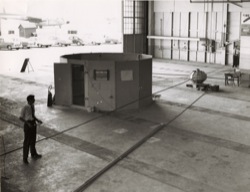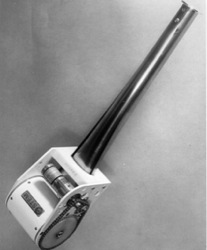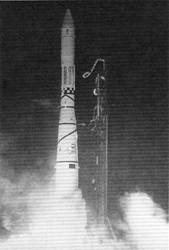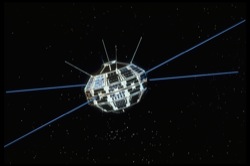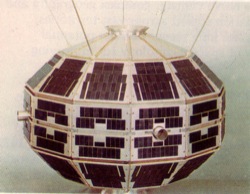Grade 9 Resources |
Grade 6 Resources |
Canada in Space |
Alouette 1 & 2 |
||||||||||||||||||||||||||||||
|
Alouette 1 Canada’s first satellite The space age officially began with the launch of the Russian satellite Sputnik on October 4, 1957. The ability to launch a satellite into space, and have it circle Earth, opened up vast new possibilities. It is no coincidence that 1957 was named the International Geophysical Year (IGY). Countries from around the world joined together to study and better understand Earth. Countries like Canada were particularly interested in understanding our atmosphere, specifically the ionosphere. Working with other countries, who were studying the lower parts of our atmosphere, a comprehensive picture of the underside of out atmosphere soon began to develop. The ionosphere is a portion of the upper atmosphere, between the thermosphere and the exosphere, distinguished because it is ionized by solar radiation. The ionosphere is a shell of electrons and electrically charged atoms and molecules that surrounds the Earth, stretching from a height of about 50 km to more than 1000 km. It owes its existence primarily to ultraviolet radiation from the sun. Even with the increased development of rockets used to study the atmosphere, little new information was being discovered about the upper side of the atmosphere. Long distance communication was not very reliable. Many countries realized that understanding the upper atmosphere might hold the key to better long range communications, or perhaps even satellite communication. With the dawn of the space age the technology to study our atmosphere from above was now available to us. In 1958 the Space Science Board of the US National Academy of sciences invited proposals for experiments that could be included on satellites launched under a new space development program. Canada’s Defence Research Telecommunications Establishment (DRTE) submitted a proposal to study the ionosphereic maximum, to the newly formed National Aeronautics and Space Administration (NASA). The proposal was accepted under a joint US / Canada project, whereby Canada would pay, design and build the satellite, and the US would provide testing and launch support. As part of the agreement Canada’s’ Defence Research Board (DRB) would establish three telemetry and command Earth stations in Canada. The project would become known as Alouette. John H. Chapman and E.S. Warren were responsible for the original proposal and continued to be associated with the program. Alouettes’ main goal was to study the top side ionosphere using what is called a swept-frequency sounder. As the engineers and scientists began to develop Alouette, it became apparent that three additional experiments could be included in Alouettes design. The three experiments were: measure cosmic radio noise, measure very-low frequency radio emissions, and measure energetic charged particles. Canada had a secondary motive for developing Alouette. We realized that space was the next frontier. Becoming knowledgeable in space technology and learning to design and build equipment that could operate reliably for long periods in this hostile environment was beneficial to the future of Canada.
Alouette was designed at built at DRTE. Satellite and rocket technology were in their infancy. Payloads had to be small, and the technology of the time was bulky. One of the major problems for Alouette were the antennas. Due to the frequency required, 45 meter antennas would be required. Fitting 45 metre antennas into a satellite that was approximately 1 metre in diameter was not an easy task.
Reliability was a major problem of the early satellites. Many of the first satellites had a life span of only a few months. Alouettes’ engineers worked hard at identifying problem areas, testing and re-testing components, and only using the most reliable parts. At the same time as the Canadians were designing and developing Alouette, the Americans were designing a comparable satellite of their own. The general feeling was that the American satellite, with their greater experience, would be superior and outlast the Canadian satellite. Alouette was originally designed to operate in space for one year. In September 1972 Alouette 1 operations were finally shut down after an unprecedented 10 years of gathering and sending back data about the upper atmosphere. In the 10 years that Alouette 1 operated more than one million ionograms were produced. Canadian scientists gained prominence as world experts on the upper atmosphere. In 1987, Alouette was designated one of the ten most outstanding achievements in the first 100 years of engineering in Canada. Within a short time after the successful launch of Alouette 1, Canada initiated negotiations with NASA for additional cooperative scientific satellites. On 23 May 1963 those negotiations led to the creation of the International Satellites for Ionospheric Studies (ISIS) program, consisting of Alouette 2, ISIS 1 and ISIS 2. Alouette 2, launched November 29 1965, was a modified version of Alouette 1 and included a probe experiment and an expanded sounder frequency range. The two ISIS satellites, launched January 30 1969 and March 31 1971 respectively, incorporated additional equipment furnished by the United States.
|
||||||||||||||||||||||||||||||
